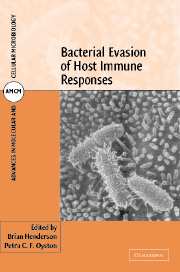Book contents
- Frontmatter
- Contents
- Contributors
- Preface
- Part I Recognition of bacteria
- Part II Evasion of humoral immunity
- 4 Evasion of complement system pathways by bacteria
- 5 Bacterial immunoglobulin-evading mechanisms: Ig-degrading and Ig-binding proteins
- 6 Evasion of antibody responses: Bacterial phase variation
- Part III Evasion of cellular immunity
- Index
- Plate section
- References
6 - Evasion of antibody responses: Bacterial phase variation
from Part II - Evasion of humoral immunity
Published online by Cambridge University Press: 13 August 2009
- Frontmatter
- Contents
- Contributors
- Preface
- Part I Recognition of bacteria
- Part II Evasion of humoral immunity
- 4 Evasion of complement system pathways by bacteria
- 5 Bacterial immunoglobulin-evading mechanisms: Ig-degrading and Ig-binding proteins
- 6 Evasion of antibody responses: Bacterial phase variation
- Part III Evasion of cellular immunity
- Index
- Plate section
- References
Summary
INTRODUCTION
The generation of diversity within bacterial populations is important in the evolution and development of bacterial species and also in the adaptability of bacteria to their changing environments. Diversity is generated by a combination of programmed and random events that occur at different rates and confer different types of variability on the population. At one extreme there are random point mutations that occur throughout the coding and intergenic sequences that alter the expression, structure, and function of bacterial components. At the other extreme, there are regulated responses that allow bacteria to control the expression of genes whenever the appropriate environmental conditions are encountered. Between these there is a variety of processes that adds to the capacity of a population to diversify, including the presence and movement of insertion sequences that affect expression, mobile genetic elements that can move within and between populations, and the horizontal transfer of DNA between individual bacteria. One process that lies between the mutations that occur randomly throughout the genome and the programmed regulation of environmentally responsive genes is phase variation. This process involves alterations in the cell at the level of DNA but in a way that generates predictable and predetermined adaptability for the bacterial population.
SECTION 1: PHASE VARIATION, ITS CHARACTERISTICS AND HOW IT WORKS
Phase variation has been recognised as a process associated with diversification since the early days of medical bacteriology (Andrewes, 1922).
- Type
- Chapter
- Information
- Bacterial Evasion of Host Immune Responses , pp. 103 - 124Publisher: Cambridge University PressPrint publication year: 2003
References
- 5
- Cited by

